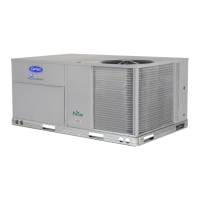59
Do not mount the IAQ sensor in drafty areas such as near
supply ducts, open windows, fans, or over he at sources.
Allow at least 3 ft (0.9 m) between the sensor and any
corner. Avoid mounting the sensor where it is influenced
by the supply air; the sensor gives inaccurate readings if
the supply air is blown directly onto the sensor or if the
supply air does not have a chance to mix with the room air
before it is drawn into the re turn airstream.
Wiring the Indoor Air Quality Sensor: For each sensor,
use two 2--conductor 18 AWG (American Wire Gage)
twisted--pair cables (unshielded) to connect the separate
isolated 24 vac power source to the sensor and to connect
the sensor to the c ontrol board t erminals.
To connect the sensor to the control, identify the positive
(4 to 20 mA) and ground (SIG COM) terminals on the
sensor. See Fig. 75. Connect the 4--20 mA terminal to the
RTU Open control ler at J4--2 and connect the SIG COM
terminal to the RTU Open controller at J4--3. See Fig. 76.
To controller
24 Vac Line
Dedicated Transforme
+
-
24 Vac
or Vdc
8 7 6 5 4
2 1
SENSOR LEGEND
1 +24 Vac/Vdc
2 Gnd (-24 Vac/Vdc)
4 -Thermistor
5 +Thermistor
6 4-20 mA
7 SIG COM
8 0-5 Vdc
C12748
Fig. 75 -- Indoor/Outdoor Air Quality (CO
2
)Sensor
(33ZCSPTCO2--01 or 33ZCSPTCO2LCD--01)
Typical Wiring Diagram
SEN
COM
J4-2
J4-3
IAQ Sensor
24 VAC
C08462
Fig. 76 -- RTU Open Controller/ Indoor CO
2
Sensor
(33ZCSPTCO2--01 or 33ZCSPTCO2LCD--01)
Connections
Outdoor Air Quality Sensor
(P/N 33ZCSPTCO2--01 or 33ZCSPTCO2LCD--01
plus weatherproof enclosure —
The outdoor air CO
2
sensor is designed to monitor carbon
dioxide (CO
2
) levels in the outside ventilation air and
interface with the ventilation damper in an HVAC system.
The OAQ sensor is packaged with an outdoor cover. See
Fig. 60. The outdoor air CO
2
sensor must be located in the
econom izer outside air hood.
Wiring the Outdoor Air CO
2
Sensor: A dedicated
power supply is required for this sensor. A two--wire cable
is required t o wire the dedicated power supply for the
sensor. The two wires should be connecte d to the power
supply and terminals 1 and 2.
To connect the sensor to the control, identify the positive
(4 to 20 mA) and ground (SIG COM) terminals on the
OAQ sensor. See Fig. 75. Conne ct the 4 t o 20 mA
terminal to the RTU Open controller at J4--5. Connect the
SIG COM terminal to the RTU Open controller at J4--6.
See Fig. 77.
SEN
COM
J4-5
J4-6
OAQ Sensor
24 VAC
C11086
Fig. 77 -- RTU Open Controller / Outdoor CO
2
Sensor
(33ZCSPTCO2--01 or 33ZCSPTCO2LCD--01)
Connections
Space Relative Humidity Sensor or Humidistat —
Humidi--MiZer
R
System Control Wiring: In units
equipp ed with the H umid i--MiZer option there are two loos e
wires loose in the control box (one PNK and one PNK/BLK)
used to control the dehumidification function of the unit.
These wires are meant to be tied to a space humidis tat or
thermidistat on an electromechanical unit. On RTU Open
controller equipped units these wires must be connected to
J11--7 and 8 to allow the Op en board to operate the
dehumid ificatio n functio n for the unit. D is con n ect the J 11
PCB style connector from the board and use the plug screws
to secure the wires as follow s: secure the PN K /BLK wires at
pin 7 and the PN K wires at pin 8, and then reconnect the
plug to the board at J11.
Relative Humidity Sensors (Space or Duct Mounted):
The accessory space humidity sensor (33ZCSENSRH-01)
or duct humidity sensor (33ZCSENDRH-01) i s used to
measure the relative humidity of air within the space or
return air duct. The RH reading is used to control the
Humidi--MiZer option of the rooftop unit. For wiring
distances up to 500 ft (152 m), use a 3--conductor, 18 or
20 AWG shielded ca ble. The shield must be rem oved
from the sensor end of the cable and grounded at the unit
end. T he current loop power for sensor is provided by the
RTU Open controller as 24vdc. Refer to the instructions
supplied with the RH sensor for the electrical
requirements and terminal locations. RTU Open controller
configura tions must be changed after adding an RH
sensor. See Fig. 78 and 79 for typical RH sensor wiring.
S J4--1 or J4--4 = 24vdc loop power
S J4--2 or J4--5 = 4--20mA signal i nput
NOTE: The factory default for dehumidification c ontrol
is normally open humidistat.

